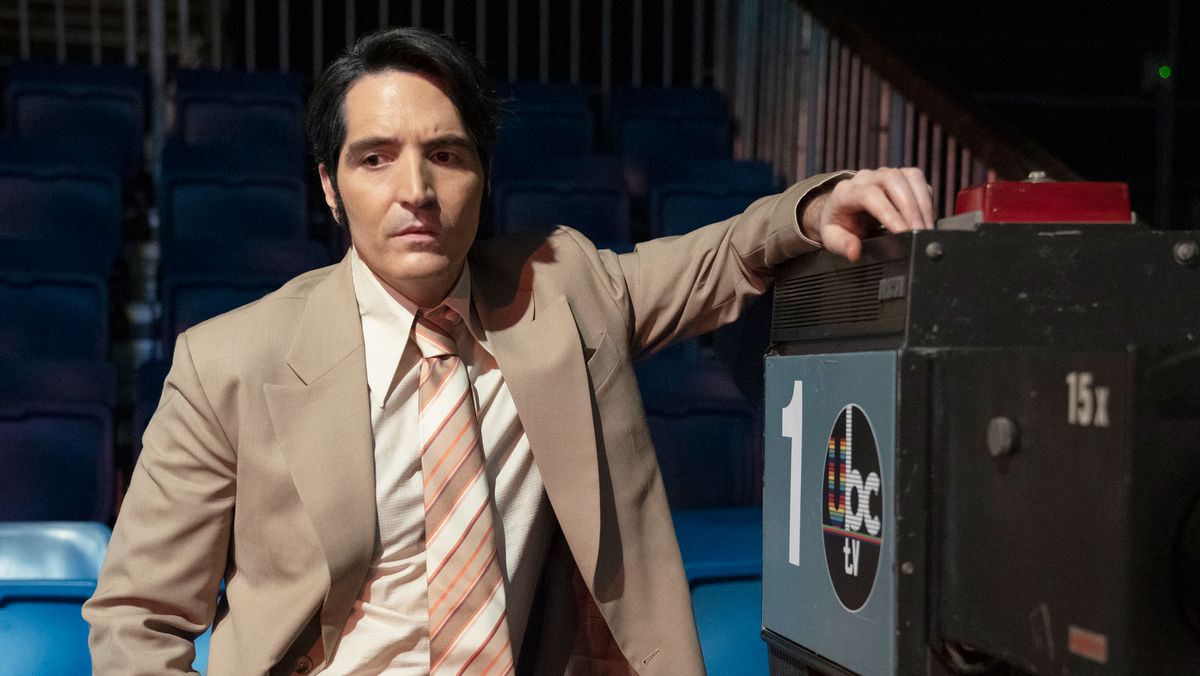Last year marked the 50th anniversary of The Exorcist, William Freidkin’s classic from 1973. One of the all-time greats of horror cinema, it’s a film that has spawned countless imitations in the years since, but most have often paled in comparison.
The latest iteration, Late Night With The Devil, attempts an intriguing new take on the premise that helps it to stand apart. Presented as a piece of lost footage from an old late night talk-show, airing back in the seventies, the film is mostly presented as a mock up of such old school, light-entertainment, in what we’re told was a special Halloween broadcast.
Among the guests – a supposed psychic who claims he can speak with the dead, a sceptic who’s made his career debunking such claims, and a parapsychologist who has with her a girl that has been possessed. As the film progresses, things become more and more sinister, as the show’s host and producers, hungry for ratings, attempt to manufacture an actual supernatural occurrence, live on the air.
The cast here are mostly impressive – David Dastmalchian in particular is brilliant as the slippery late-night host Jack Delroy, playing the part of the seemingly typical late-night entertainer, careful to maintain his easy-going, jovial television personality whilst keeping a tight lid on his murky past. The various guests he has on are for the most part playing up to different archetypes from this era, all of which they capture reasonably well; although Ingrid Torelli as possessed girl Lily perhaps does once too often stray too far towards being over the top.
The central premise here is a great one. The key concept of a real-life haunting happening live on air, in front of viewers, is one that bears clear similarities to previous mockumentary efforts, such as Ghostwatch, the iconic BBC film, and makes for a distinctive way of approaching the found-footage genre.
The segments of the film taking place entirely within this format, as an actual live broadcast, for the most part come off really well, both for selling the horror aspects of the film, as well as working as a satire of the time. The production design and costuming all help to sell the feel of this being an actual broadcast from the seventies. The main storyline is one clearly inspired by the horror films of that era, as well as popular concerns at the time around hippy youth movements, the reactions to the Vietnam War, and of course – somewhat later on – the start of the ‘Satanic Panic’. The framework of this fictional show, with the attempts by Delory and others to use or to control the possessed Lilly, helps to add an extra dimension of uncertainty and tension to the scenes where they attempt to summon up the demon lurking inside her.
Because of the conceit behind this film, there needs to be a proper sense of tone and cohesion for it to work, something that the film often lacks. Many have already commented about the use of AI in creating some of the 70s style title cards for the ad breaks that pop up throughout, with much of the conversation focusing on what this says about the art form if creators are increasingly going to be using AI as a substitute for actual filmmaking.
While I hadn’t noticed that AI was being used, it does seem indicative of a wider problem throughout this film, in that whilst the premise is great, there is overall a lack of effort in following through in some of the ideas it presents, which lowers the film to the level of much standard horror fare.
For example, whilst the look of the set and the costumes help to perfectly set the tone of this being a seventies production, the film quality alone instantly shows this to be a modern production. Whereas other faux-period pieces or found-footage films have gone all in in recreating the look of low budget or old-style filmmaking, Late Night With The Devil is clearly shot in much the same way as any contemporary film – a minor point perhaps, but one that helps to weaken the illusion that this is actual footage you are seeing.
The same issue comes from the obvious uses of CGI for the electric shocks that take place, the jarring, gross-out moments that come with one character vomiting, or another whom we see covered in worms, as well as the continual switches to footage from behind the scenes, where we follow the characters around in moments that are taking place away from the cameras. These scenes, whilst adding points that are important for the plot, help to break the immersion of the piece, and when, in the third act, we’re treated to full-on moments of gore, it ends up feeling incredibly over the top, and a lot of the suspension of disbelief that the film has built up is lost.
Throughout, Late Night with the Devil seems often to be lacking for much of a sense of subtlety, or a willingness to stick with the framework it first sets up, which it becomes apparent, is the main distinguishing feature it has from the multitude of other films in the this mini-genre. Ultimately, it might have been a far more memorable entry had it stuck with this initial, highly intriguing premise, instead of attempting to do too much at once.
READ NEXT: 15 Underrated Horror Movies on Shudder You Should Watch
Some of the coverage you find on Cultured Vultures contains affiliate links, which provide us with small commissions based on purchases made from visiting our site.


